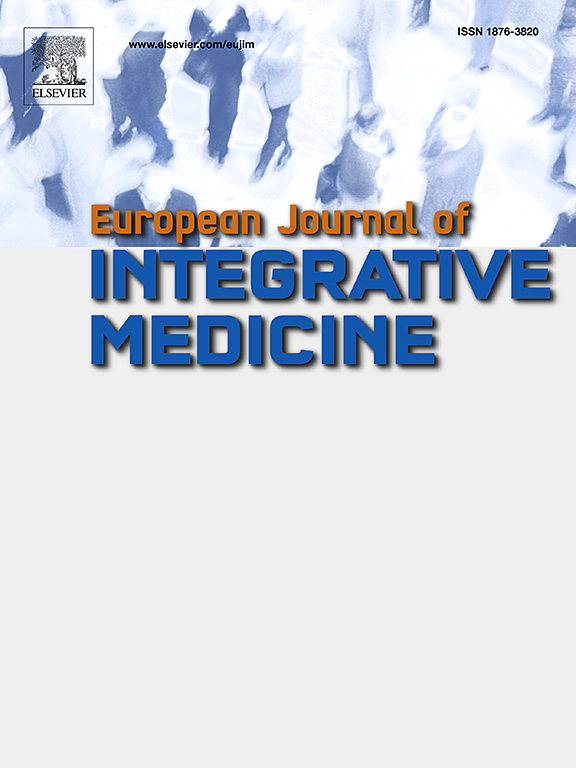Effectiveness of acupotomy combined with epidural steroid injection for lumbar radiculopathy: A systematic review and meta-analysis
IF 1.7
4区 医学
Q3 INTEGRATIVE & COMPLEMENTARY MEDICINE
引用次数: 0
Abstract
Introduction
Acupotomy—a combination of acupuncture and minimally invasive surgery—is a commonly used traditional East Asian medical intervention for treating patients with lumbar radiculopathy (LR). In this study, we aimed to evaluate whether a combination of acupotomy and epidural steroid injections (ESIs) was more effective than ESIs alone or ESIs with interventions other than acupotomy for LR patients.
Methods
Randomized controlled trials (RCTs), which used acupotomy and ESIs in patients with LR, were retrieved from thirteen databases on June 10, 2024 (PROSPERO CRD42023435441). Included studies assessed outcomes using the pain Visual Analogue Scale (VAS), total effective rate (TER), Oswestry Disability Index (ODI) and adverse events (AEs). Cochrane’s Risk of Bias Tool 2 (RoB2) was employed to assess the risk of bias in the studies. The Grading of Recommendations, Assessment, Development, and Evaluation tool was also used to assess the quality of the evidence.
Results
Five studies involving 577 patients were included in this review. Compared with ESIs alone, a combination of acupotomy and ESIs led to improvement in pain VAS scores (three RCTs, standard mean difference [SMD] −0.73 [−1.01 to −0.45], very low certainty of evidence [CoE]) and TER (four RCTs, risk ratio 1.31 [1.02 to 1.69], very low CoE), although most studies were evaluated as high risk in the RoB2 evaluation. However, the combination showed no improvement in ODI (two RCTs, SMD 0.46 [−1.58 to 2.50], very low CoE). There were no major AEs.
Conclusion
Although the quality of the evidence was very low, combined acupotomy and ESIs proved more effective than ESIs alone for LR patients. Further rigorously designed studies are warranted to confirm the effects of combination therapy on LR patients.
针刀联合硬膜外类固醇注射治疗腰椎神经根病的有效性:一项系统回顾和荟萃分析
针刀是针灸和微创手术的结合,是一种常用的东亚传统医学干预手段,用于治疗腰椎神经根病(LR)。在这项研究中,我们旨在评估针刀联合硬膜外类固醇注射(ESIs)是否比单独使用ESIs或ESIs与针刀以外的干预措施更有效。方法于2024年6月10日(PROSPERO CRD42023435441)从13个数据库中检索使用针刀和ESIs治疗LR患者的随机对照试验(RCTs)。纳入的研究使用疼痛视觉模拟量表(VAS)、总有效率(TER)、Oswestry残疾指数(ODI)和不良事件(ae)评估结果。采用Cochrane 's Risk of Bias Tool 2 (RoB2)评估研究的偏倚风险。建议、评估、发展和评价的分级工具也用于评估证据的质量。结果本综述纳入了5项研究,涉及577例患者。与单独使用ESIs相比,针刀联合ESIs可改善疼痛VAS评分(3项随机对照试验,标准平均差[SMD] - 0.73[- 1.01至- 0.45],证据确定性[CoE]极低)和TER(4项随机对照试验,风险比1.31[1.02至1.69],极低CoE),尽管大多数研究在RoB2评估中被评为高风险。然而,联合用药没有改善ODI(两个rct, SMD为0.46[- 1.58至2.50],非常低的CoE)。无重大不良反应。结论虽然证据质量很低,但对于LR患者,针刀联合穿刺比单纯穿刺更有效。进一步严格设计的研究是有必要的,以确认联合治疗对LR患者的影响。
本文章由计算机程序翻译,如有差异,请以英文原文为准。
求助全文
约1分钟内获得全文
求助全文
来源期刊

European Journal of Integrative Medicine
INTEGRATIVE & COMPLEMENTARY MEDICINE-
CiteScore
4.70
自引率
4.00%
发文量
102
审稿时长
33 days
期刊介绍:
The European Journal of Integrative Medicine (EuJIM) considers manuscripts from a wide range of complementary and integrative health care disciplines, with a particular focus on whole systems approaches, public health, self management and traditional medical systems. The journal strives to connect conventional medicine and evidence based complementary medicine. We encourage submissions reporting research with relevance for integrative clinical practice and interprofessional education.
EuJIM aims to be of interest to both conventional and integrative audiences, including healthcare practitioners, researchers, health care organisations, educationalists, and all those who seek objective and critical information on integrative medicine. To achieve this aim EuJIM provides an innovative international and interdisciplinary platform linking researchers and clinicians.
The journal focuses primarily on original research articles including systematic reviews, randomized controlled trials, other clinical studies, qualitative, observational and epidemiological studies. In addition we welcome short reviews, opinion articles and contributions relating to health services and policy, health economics and psychology.
 求助内容:
求助内容: 应助结果提醒方式:
应助结果提醒方式:


